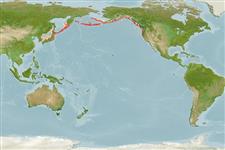Classification / Names
Common names from other countries
Main reference
Size / Weight / Age
Max length : 183 cm TL male/unsexed; (Ref. 2850); max. published weight: 91.0 kg (Ref. 2850)
Environment
Marine; bathydemersal; depth range 0 - 680 m (Ref. 50610)
Climate / Range
Deep-water, preferred ?; 62°N - 36°N, 127°E - 121°W
Distribution
Short description
Dorsal
spines
(total): 11 - 12;
Dorsal
soft rays
(total): 13-16;
Anal
spines: 3;
Anal
soft rays: 10 - 12. Body stout. Head round on dorsal profile. Dorsal fin separated by a space less than eye diameter. anal fin without a distinct spine. Young fish with striking white blotches on body. Color changes to dark gray.
IUCN Red List Status (Ref. 115185)
Threat to humans
Harmless
Human uses
Fisheries: commercial; gamefish: yes; aquarium: public aquariums
More information
ReferencesAquacultureAquaculture profileStrainsGeneticsAllele frequenciesHeritabilityDiseasesProcessingMass conversion
Tools
Special reports
Download XML
Internet sources
Estimates of some properties based on models
Phylogenetic diversity index
PD50 = 1.2500 many relatives (e.g. carps) 0.5 - 2.0 few relatives (e.g. lungfishes)
Trophic Level
4.5 ±0.37 se; Based on food items.
Resilience
Very Low, minimum population doubling time more than 14 years (Preliminary K or Fecundity.)
Vulnerability
Very high vulnerability (85 of 100)
Price category
